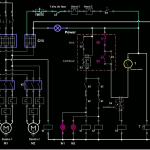Centrifugal pumps vs. positive displacement pumps.
Pumps are generally classified as Centrifugal Pumps (or Rotodynamic Pumps) and Positive Displacement Pumps.
Centrifugal pumps (rotodynamic pumps)
The centrifugal or rotor-dynamic pump produces head and flow by increasing the velocity of the liquid through the machine with the help of the rotating vane impeller. Centrifugal pumps include radial, axial and mixed flow units.
Centrifugal pumps can be further classified as
- end suction pumps
- in-line pumps
- double suction pumps
- multistage vertical pumps
- horizontal multistage pumps
- submersible pumps
- self-priming pumps
- axial flow pumps
- regenerative pumps
positive displacement pumps
A positive displacement pump operates by alternating filling a cavity and displacing a given volume of liquid. A positive displacement pump delivers a constant volume of liquid for each cycle regardless of discharge pressure or head.
The positive displacement pump can be classified as:
- Alternative pumps – piston, piston and diaphragm
- energy pumps
- steam pumps
- Rotary pumps – gear, lobe, screw, vane, regenerative (peripheral) and progressive cavity
Selection between centrifugal or positive displacement pumps
The selection between a centrifugal pump or a positive displacement pump is not always straightforward.
Flow rate and pressure head
The two types of pumps behave very differently in terms of head and flow rate:
- The Centrifugal Pump has variable flow depending on system pressure or head
- The Positive Displacement Pump has a more or less constant flow, regardless of system pressure or head. Positive displacement pumps generally draw more pressure than centrifugal pumps.
Capacity and Viscosity
Another big difference between pump types is the effect of viscosity on capacity:
- In a centrifugal pump the flow is reduced when the viscosity is increased.
- In a positive displacement pump, the flow is increased when the viscosity is increased
High viscosity liquids fill gaps in Positive Displacement Pumps causing greater volumetric efficiencies and Positive Displacement Pumps are better suited for higher viscosity applications. A centrifugal pump becomes very inefficient even at modest viscosity.
Mechanical Efficiency
The pumps behave differently considering also the mechanical efficiency.
- Changing system pressure or height has little or no effect on flow rate in a positive displacement pump.
- Changing system pressure or head can have a dramatic effect on the flow rate in a centrifugal pump.
Positive Net Suction Head - NPSH
Another consideration is the Net Positive Suction Head-NPSH.
- In a Centrifugal Pump, the NPSH varies as a function of the flow determined by the pressure
- In a Positive Displacement Pump, the NPSH varies as a function of the flow determined by the speed. Reducing the speed of the positive displacement pump reduces the NPSH
Source: https://www.engineeringtoolbox.com/classification-pumps-d_55.html










